So, first things first. Here is what the incubator looked like early Saturday morning.
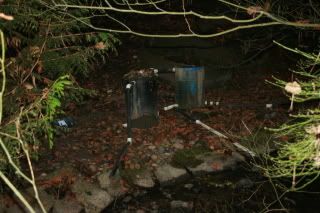
The incubator is on the left; the clarifier is on the right. The piping on the right leads 500' up the creek to the inlet tube. Water flows in at the bottom of the clarifier and then out at the top. It goes into the bottom of the incubator and then out again at the top. Notice that there is no water flowing out of the outlet tube on the incubator. Both the incubator and clarifier have the crud of one season out in the weather goobering up their outsides. The insides are a bit murkier than that.
This is what the inside of the clarifier looked like before I began cleaning anything up. It is a mix of sand, silt and leaves (I had left the top off the clarifier and it is surrounded by trees.
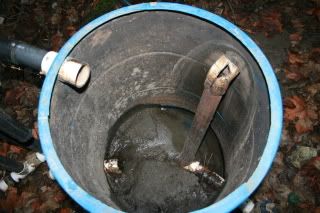
First things first. Getting water flowing through the system will make everything else easier. As I said earlier, the inlet pipe is about 500' up creek from the incubator. It is a 6" diameter pipe with a bunch of holes drilled in it. During the course of the previous year, McAleer Creek had changed its flow pattern a bit, so the inlet pipe wasn't getting any water. The first thing I had to do was fix that. This is what the inlet pipe looked like before I began work.
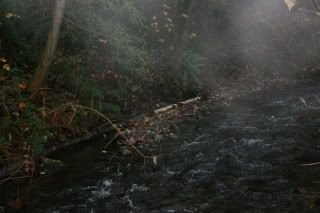
I modified the creek bed as little as possible (there are all kinds of insects and other critters that live in the gravel/sand/rocks and I wanted to make as small a disturbance as possible), but still managed to get enough water flowing to cover most of the inlet tube. That took almost two hours.
After lunch, I came back out to the incubator and water was flowing through the clarifier. I cleaned that out and then started on the incubator itself. There wasn't much in there; just the stuff at the very bottom, which I'll show you pictures of all cleaned up. The incubator is a 50 gallon plastic drum (the only metal you can use is stainless steel, everything else gives off ions that will be bad for the fish, so we use stainless steel screws to hold the piping together). The water flows in at the bottom into a cross-shaped piece of piping that has holes drilled in the bottom (so that the force of the water is disapated against the bottom of the barrel and rises gently through the other layers). It looks like this:
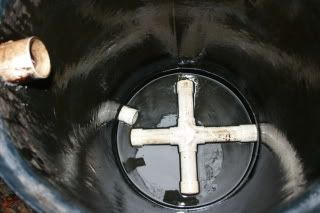
Don't get too confused by it; it's kinda clean and shiny inside, so there's that wierd curvy reflection on the right hand wall. There's also a clean-out pipe at the bottom and the outlet pipe at the top, both on the left hand side of the barrel.
Next I put down the stainless steel screen that supports everything else.
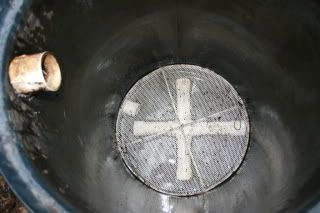
It is supported by a ring of white plastic and some cross bracing across the diameter.
Next comes a layer of pea gravel about 1" thick.

Before I got started cleaning the incubator, that pea gravel was covered with a layer of silt about 1" thick; a dense mass of yuck that had to be cleaned out mostly by hand. At the end, though, I poured gallons and gallons of water in there and let everything flow out the clean out pipe at the bottom.
On top of the pea gravel I will put a bag of plastic media that look like barrels with a bunch of slots cut out of them. This is one of them:
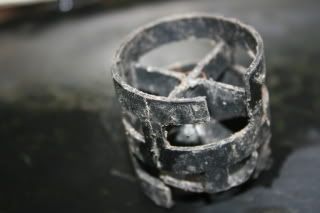
The whole bag of them looks like this:

As you can see, they don't stack together very well. Once the eggs hatch out, the alevin (what a just-hatched salmon is called) will swim down through the trays and hide out in the media for a couple of months. All of those nooks and crannies are good places for hiding. In the wild they would do this by burrowing into the spaces in the gravel around their nest.
Tomorrow, when I get the eggs, you won't see any of that stuff (and I won't see if for another 3-4 months once the eggs are loaded into the incubator), but you will see the trays that go on top of the bag of little barrels. Here are all five of them stacked in my garage.
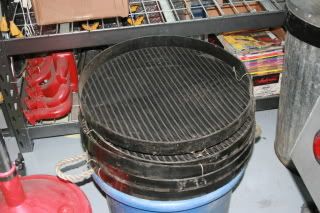
Once I got the water flowing through the incubator, it was time to optimize its flow. To support 70,000 eggs/alevin/fry (actually the barrel can hold 125,000 if you can believe that), you need about 10 gallons of cold, well-oxegynated water flowing through the system. The eggs will breathe that oxygen directly from the water; the alevin/fry will breathe it as well once they appear. At the beginning of optimization we were getting about 5 gallons/minute (maybe, I didn't bother to measure it, just estimated it by eye, having seen water flow out of the incubator for the last decade). This is what it looked like (notice how much cleaner and well ordered everything is than in the first picture - I was working hard):
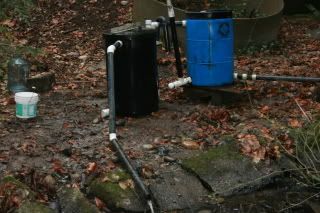
Optimizing means flushing all the gunk out of the lines and then bleeding the air out of the pipes at the high spots. If the pipe fell in a perfectly straight line from the inlet to the clarifier, the bleeding would be unneccessary. But the pipe rises and dips, doing its best to follow the level of the stream, but not completely succeeding. Hence the need to fiddle with it.
Here's a picture of my son, Francis, flushing out one of the pipes.
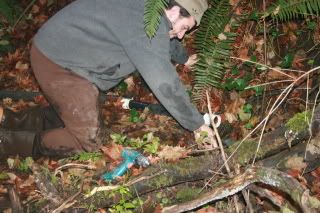
Notice the cordless drill by his knee? That's what we use to bleed the system. As I said earlier the pipes are held together with stainless steel screws at the junctions of each 10' section. You just unscrew one or both screws and let any air trapped in that section of pipe escape. It's really pretty simple.
While we were walking through the creek we saw a really cool sign. This is it:
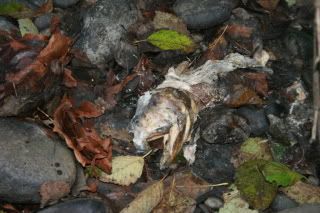
Yes, that is a dead salmon head lying in the gravel on the side of McAleer Creek. This is a very good thing for at least two reasons. One, it means we are getting returning fish. Two, once the fish die they begin rotting in place. Their bodies provide fertilizer for the plant life along the stream which feeds the insects that will become the food for their little babies. Circle of life, Indeed.
By the time we were through flushing the pipes it was 3:30. I had to leave to get ready for dinner and a UW men's basketball game (vs Texas Southern, which they won 88 - 52, bringing our record to 6-3), so Francis finished bleeding the system in the dark (sunset is early in December in the Pacific Northwest, it's full dark by 4:30 these days). When I checked the incubator the next morning, we were getting flow of a little better than 10 gallons/minute. We are ready.
Tomorrow is the big day. My daughter, Gwynedd, is accompanying me and will be taking pictures, so I'll give you the complete pictorial rundown of loading fish into the barrel either tomorrow or Thursday night. We leave for Issaquah Hatchery around 7:30 tomorrow morning. I know it seems silly, but I am tremendously excited. I really like doing this project; it gives me a sense of participation in the natural world that is significantly more intense than just watching it all from my windows.
No comments:
Post a Comment